Cards on the table time: I love action, I’m intrigued by Catholic guilt and its relationship to vigilante justice, and I love long-winded conversations about morality, so Daredevil is an easy sell for me. Going into the Netflix’s second season I was a little nervous, because (a) I’m not into Punisher, and (b) I tend to get sick of Elektra. So how is it that in a season featuring a Punisher who made me cry, an Elektra I found riveting, plus many (many) long-winded conversations about morality, the one element of the show I can’t stop thinking about is Karen Page?
I didn’t even like Karen Page last season.
(Note: Spoilers for season 1 and 2 of Daredevil.)
Well, OK, that’s not quite fair. We were introduced to her as a brave/terrified young woman, in over her head but still fighting for the truth as her old employers tried to frame her for murder. Your heart would have to be carved from granite not to root for anyone in that situation, and Deborah Ann Woll did a tremendous job selling it. She was wide-eyed, exhausted, shaking like a Chihuahua in a lightning storm. Even when she was presumably safe, it was clear that she would be haunted forever.
When Matt and Foggy hired her I was excited that the show committed to following the fallout in her life, rather than becoming the ‘case of the week’ show I was expecting. But as the season unspooled, I found myself turning on her. I was irritated by her crush on Matt because it felt more like she’d imprinted on the nice man who saved her from jail more than a genuine interest in who he was as a person. (And when she asked Foggy to touch her face, in an incredibly gross attempt to substitute him for Matt, I recoiled from the screen.) Even worse, her fumblings into Wilson Fisk’s past and inept attempts at detective work started to feel like Harriet the Spy had just wandered into the grittiest corner of the Marvel Cinematic Universe. She lied to everyone, she hid things constantly, and worst of all, her half-assed investigation led directly to the death of both Ben Urich and Wesley. (My second and first favorite characters, respectively.) But it was actually Wesley’s death—at Karen’s hands—that started to turn me back to her.
“Do you really think this is the first time I’ve shot someone?”
With that one line, Karen takes her narrative back from Wesley. Just as in her first meeting with Nelson and Murdock, she’s being held against her will and facing off with a man across a table. She’s in an uncontrollable situation, and thinks she only has moments to live. No one knows she’s here. There’s no reason to think the Devil of Hell’s Kitchen will show up to deus ex machine her out of this. But even in her obvious terror, she’s icily specific. Think how differently this scene could play out if she’d said, “You think this is the first time I’ve ever shot a gun?” And when she does shoot Wesley, it’s not just one panicked shot to incapacitate him, but repeatedly, until she’s sure he’s dead.
From then on she acts like someone who has done this before. She knows how to get rid of evidence, she knows to wipe her prints from the table, she throws the gun into the river, and takes one of those endless post-murder showers that can never quite get the smell of blood out of your nose. She turned back into a character I wanted to explore further—not because she was willing and able to shoot, but because she reacted to her murder the way a normal human would react. Even though it was self-defense, it was a weight she was going to feel for the rest of her life.
In Season Two the show goes in many different directions, and shows us new sides to the characters. Foggy is still the heart of the law firm, and he displays his growing confidence in his job, while Matt, well, acts like a dick. There’s no way around this, guys: Matt’s messiah complex has gone to his head. When you’re arguing moral nuance with the Punisher, and losing? It’s time to re-examine some shit. But it’s Karen who shows the most growth and depth, and by the end of the season becomes an essential character. Karen is still processing what happened with Wesley—and possibly whatever happened in her past that made her good with a gun. While Matt preaches endlessly about giving everyone a second chance, and God being the only one who can decide who lives and who dies, Karen is the one who actually responds to killers with empathy. Matt doesn’t sit by Grotto’s side—Karen does. She concocts a cover story for him off the top of her head, she’s the one who gets him out of the hospital safely when the Punisher shows up, and she’s the one who advocates for him. She almost bolts out into the middle of another Punisher attack to rescue him. That this is empathy, not pity, is clear when Grotto asks her to kiss him for good luck; she holds up a middle finger instead. She’s not trying to make Grotto feel better, but she believes that as a client and a human, he deserves their help. The same consideration she hopes she would receive, presumably, if Foggy and Matt knew her own past. She is willing to stake her life on this belief.
We also see the evolution of her Harriet the Spy tendencies. Where Season One Karen was sloppy in her attempts to uncover Wilson Fisk’s past, Season Two Karen shows that she’s learned from Ben Urich, and attempts a covert, journalistic investigation into Frank Castle and the DA’s vendetta against him. She goes to the DA’s assistant for information, and when Nelson and Murdock both tell her to give up on the case, she first talks to Urich’s old boss Ellison and asks to see the paper’s archives. Rather than being daunted by the piles of aging newspaper she dives right into research, spending hours to find the truth about a man that most see as a monster. It’s inevitable that she go to Castle’s home, inevitable that she does her best to remain respectful even as she sifts through his privacy, inevitable that she alone sees him as a person. Again she goes into a dangerous situation without taking anyone with her, or even telling anyone where she’ll be, because she knows that no sane person would take the risk she’s about to take. But she still feels that it’s her moral duty to explore Frank Castle’s past. The biggest change is that this post-Urich Karen is more wary of danger; she keeps her guard up and escapes the house when the mysterious Suits show up at Castle’s door.
When Castle rejects both Nelson and Murdoch—the actual lawyers—and chooses to speak to Karen about the case, this is why. It’s not because she’s the woman, or because he wants to apologize for terrifying her with a shooting spree; it’s because she alone was willing to go to his house and engage with the humanity that was taken away from him. Castle is willing to spill his family’s tragedy to Daredevil because he’s half-dead and the cops are on the way—it’s entirely possible that this will be his last chance to tell his story. Here the show is telling us something sad, explaining pain through a monologue. But Karen’s silent tour of Castle’s home is the show trusting us to experience that pain. We’re expected to allow Castle’s loss to enter our own minds without the mediation of an actor monologuing. This is the scene that gives us the real weight of Castle’s loss, and shows us why he became the Punisher. By structuring this arc in this way, the audience is allowed to connect the dots as Frank speaks. We can see him sitting in his daughter’s room, refusing to read her book. We can see that this space has become sacred in his mind, and so we jolt when we realize, along with him, that Karen has been there.
Matt attempts to become the Punisher’s Father Confessor; Fisk treats him like an attack dog he can unleash; Foggy begins and ends openly terrified of him. Karen, on the other hand? She defends him to Matt, rejecting all of his good Catholic attempts to push her into agreeing with him, and remain the sweet girl she is in his mind—she even allows this argument to ruin their second date. She’s the one who talks Frank through the arguments Matt and Foggy make on his behalf, to make sure he understands. She insists that he has a moral code—and that’s after he pursued her through a hospital like The Terminator. She’s the one he comes to after his escape from prison, and she’s the only one who wouldn’t shoot on sight when he turns up at her door. He even listens to her when she tries to talk him out of killing. (Unlike Matt, Karen has earned the right to talk to Frank about his moral choices.)
Finally, I think her responses to Matt show her growth more than anything. As the season unfolded I was dreading the point where Karen would be held up as the “good” girl, the sweet, small-town blonde, to contrast with Elektra, the dark-haired “bad” girl who kills ninjas for fun. The show sidestepped that potential land mine by making both women complex, interesting, and best of all, driven by their own passions instead of just acting as foils to Matt Murdock. And it does offer a few mirroring moments—Karen’s idea of a great date is inexpensive Indian food, while Elektra loves luxuriant foods like caviar and champagne. Both women knot Matt’s tie for him—but when Karen does it she’s helping him dress for a funeral, while Elektra is knotting his bow tie as they infiltrate a fancy Roxxon soiree. The show gives us these examples without comment, but it’s Matt who pushes this contrast. He wants Karen to be the “good” girl—the light that pulls him away from the “darkness” of Elektra. Especially during their heated Punisher conversation, Matt offers Karen a chance to retreat into a simple, black and white world, and she refuses. Karen’s world was never simple or innocent, and she’s not the fragile creature Matt has created in his mind. But after he’s basically abandoned her and Foggy for most of the season, Matt pulls a White (Red?) Knight, demanding a chance to protect her. Karen shuts him down with my favorite thematically-loaded line of the season: “I am not yours to protect.” Perhaps she’s the voice of New York, demanding that Matt examine why exactly he wears that suit every night…
I’m not saying that Karen’s arc was perfect—it’s ludicrous to imagine that she’d be allowed to move into Ben Urich’s private office, interview people, and stare at a blank white screen for months while real journalists are doing real journalism in shitty cubicles all around her. But when she finally steps into her new career and begins writing her article about costumed vigilantes, she finds her voice by interrogating the idea of the hero. She states up front that heroes aren’t costumed vigilantes or gods from other worlds, but the New Yorkers reading the article, who look themselves in the mirror each morning and set out to work in their city. Is it cheesy? Yes. Would a New York newspaper ever pay her to write it? Hell no. But by affirming her neighbors as heroes, and implying that she considers herself, Foggy, Ellison, Ben Urich, et al, to be the heroes the city needs, she brings Daredevil back down from the rooftop ninja wars, chain fights, and murky occult scheming that Matt finds himself lost in. As the one who stands by Grotto and Punisher, who stands for community and justice, she effectively replaces Matt as Daredevil‘s moral center, and embodies the soul of the show.
Leah Schnelbach is sorry about all the mean things she said to Karen last season. Come debate morality with her on Twitter!










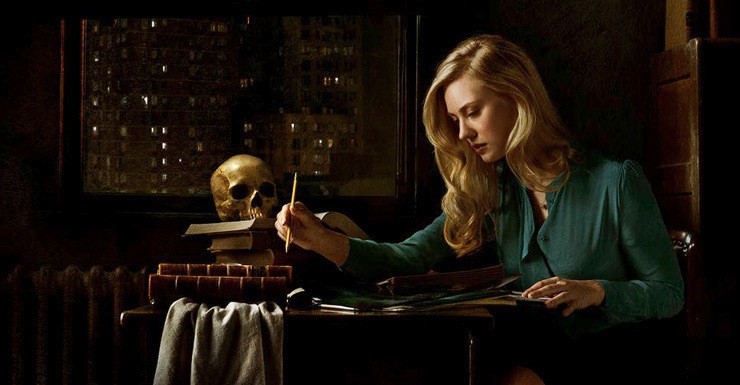
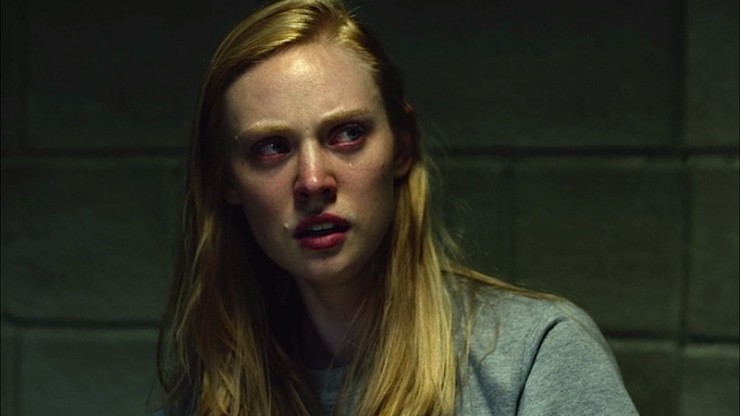
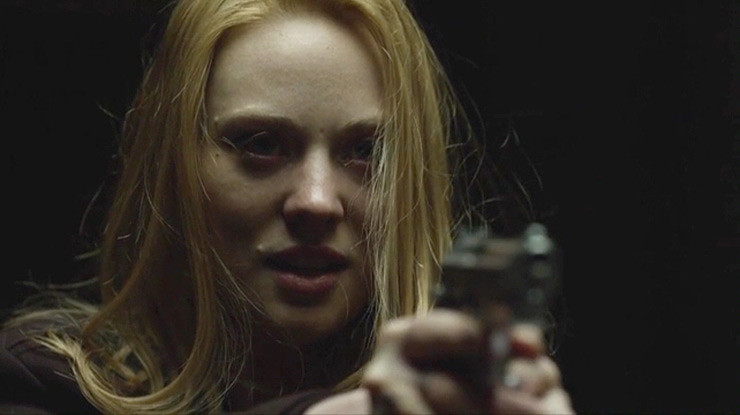
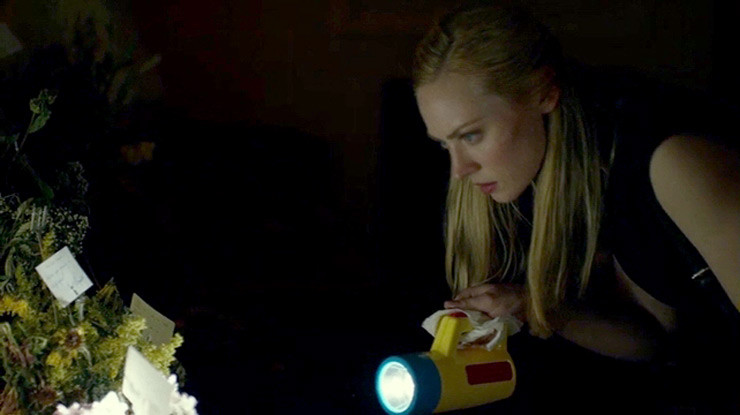
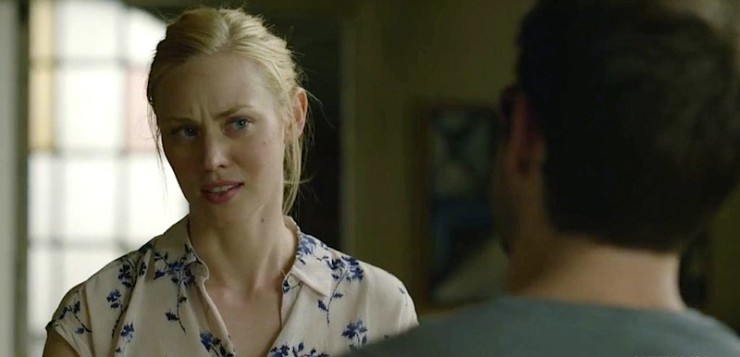
I’ve only seen up to episode 5, but I’m loving Karen this season, (and am irritated to no end with Matt!). I’m afraid I sometimes see her as the light to counter Elektra, too (Elektra just irritates me), but I don’t want her to be some angel doll in Matt’s head. I’d better catch up on the series!
At one point, while watching this season, I texted my brother to note (paraphrasing) “Girl-next-door-type whose interests include justice, research, and showing up with coffee for everyone? Netflix-Karen-Page, get out of my stream and get into my car!“
Ok, I actually couldn’t stand Karen in Season Two. I found her constant hairplay annoying and it always felt like she (the actress) knew she was on camera. Too act-y for me…but you’ve made such good points here it almost makes me change my mind. I am curious about her backstory and do like that they made her more complex. This is a fabulous (and fun) recap!
:)
Super well thought out article, Leah. I enjoyed that.
First, great article. Loved it
I liked the first season of Daredevil, I didn’t love it, but anything over the Ben & Jen fiasco would have been an improvement. Last season gave us a great Kingpin, thank you! I didn’t dislike Karen last season and Foggy just wouldn’t shut up and go away but by the end of the season Matt had on the red suit and Kingpin was awesome again, and Ben & Jen were long forgotten.
This season: I LOVED! This is the Daredevil I had always hoped to see. Speaking about doing an iconic Marvel character right, the third times the charm for the Punisher (or has it been more). This was a great Punisher, the actor who played him was amazing. Elektra was good, not great, but it wasn’t Jennifer Garner so I am thankful for that. The fight scenes with Daredevil & Elektra were outstanding. But seriously this season was all about the Punisher for me. If I had to describe this season in one word, it would be: BRUTAL!
Foggy who whined a bit too much in season one for my tastes doubled down on the whine in season two. What I had hoped for going into Season Two was that Foggy had gotten all of his Angsty Not On Board With The Daredevil ‘tude out of his system and he’d be more on board or at least we wouldn’t get any more of his tedious lectures to Matt. (Long) Sigh. Foggy was the only part of this season of Daredevil that I wasn’t all in on. Every time he opens his mouth now I hope someone will come along and shut it for him.
Other than Foggy, the thing that bugged me was the continued story that Foggy told Karen that Matt was a drinker /alcoholic so that’s why he didn’t show up for work or was a bit worse for wear in the morning. They used it as a throw away cover for his activities and never really explored the consequences of it except for Karen to be disgruntled with Matt from time to time about the “drinking”. Bad storytelling for a serious topic used as a throwaway especially considering Karen & Foggy’s mass consumption of the alcohol beverages on a nightly basis kills this storyline all together
Karen…saves the show. If it was just Foggy & Matt bickering back and forth like two old men over a chess board I’d pray for the Kingpin to squash both of them to mush. I dig the fact that she’s turned all Nancy Drew.
A great article. Love Karen. Foggy can go away. And please please please let there be a Punisher series with the same actor.
I was bored by this season. Don’t get me wrong, I watched the whole thing over the weekend and enjoyed it decently–but over all I was bored.
Karen wasn’t a break out for me–she was a holding pattern on of consistently being in trouble and surviving by some miracle and being a love interest with not enough build up or support for me to care. ‘I’ve been used before but, sure, lets a very similar thing again just because–surely it won’t have nearly the same result again’ was the way I kept reading it (though honestly I stopped bothering paying full attention throughout several of the episodes–though I guessed the ‘twist’ a mile away). I also both couldn’t buy the love story because, well, Matt was consistently MIA from the Law Firm and any of his co-workers lives for the most part. Is it a relationship if you go on one date and then basically spend no time with each other? The Punisher seems to think so–but, then, the Punisher spent an awful lot of time talking about his dead daughter and how she motivated him to kill (the rest of his family died too, but I heard a lot more about one member than the rest)
For me, the second season seemed far more in love with its video game like ‘action scenes’ than anything else… and the characters might have suffered for it. Motivations were yawn worthy. I’d try a third season but wouldn’t bother to rewatch this one.
i was googling ‘Why no love for Karen Page’ when I found this article. You have essentially written every word I wished to express, so thanks for saving me the time (and doing it better too) .
Excellent analysis. I really appreciate your thoughtful writing. I think the show is very well constructed and it has themes that get under your skin. I just realized how, ironically, it was Ben’s death that rescued he and his wife from having to deal with where to put her. When he died, all his insurance paid out. Again, thanks for pointing out details that I missed. Cheers!
Karen Page is easily the WORST character in the show.
She’s still as whiny and as meddling as before. Either putting herself or others in danger and yet never is accountable for her actions. For all her gumption it often translates to naivete or straight up stupidity. She still doesn’t know how to pick and choose her battles wisely and has to be constantly saved by either Frank or Matt. The character this season has the illusion of doing something but when you really analyze it she contributes nothing that Matt or Frank don’t already know. Her becoming a journalist taking over a much seasoned veteran despite not ever having any education or writing experience whatsoever is just plain stupid. Not to mention her “article” (and I use the term loosely) reads like it was written by a 10 year old. Or how she magically appears in every situation just because the writers want her there. She’s supposed to be in protective custody and yet she’s with the police at the docks – in an active crime scene mind you. Why? So she can worry about Frank and have Daredevil hear her heartbeat? Give me a break, I just find that silly. Or you see her in court with the lawyers for no other reason that I can think of other than to put her in the scene to give her something to do. or her butting in on legal conversations without any form of legal education or even paralegal experience. You can do that with a character like Becky Blake who was a secretary after Karen Page in the comics because she was actually studying to become a lawyer and eventually became one.
Everything that happens to Karen in the show never happens organically or naturally as part of the progression of the story. So her being at the center of almost every event is jarring on so many ways.
All of the things they tried to do with Karen this season seems like a rather flimsy attempt at making her seem more than she actually is to the point that none of it seems quite believable anymore. In an effort to make her seem more interesting, they’ve made her a walking talking plot device.
Karen Page was one of the main problems of Season Two. It’s bad enough that she was indirectly responsible for Ben Urich’s death. Then following his death . . . SHE BECOMES A REPORTER . . . with no previous experience, training or education in journalism? What the hell?